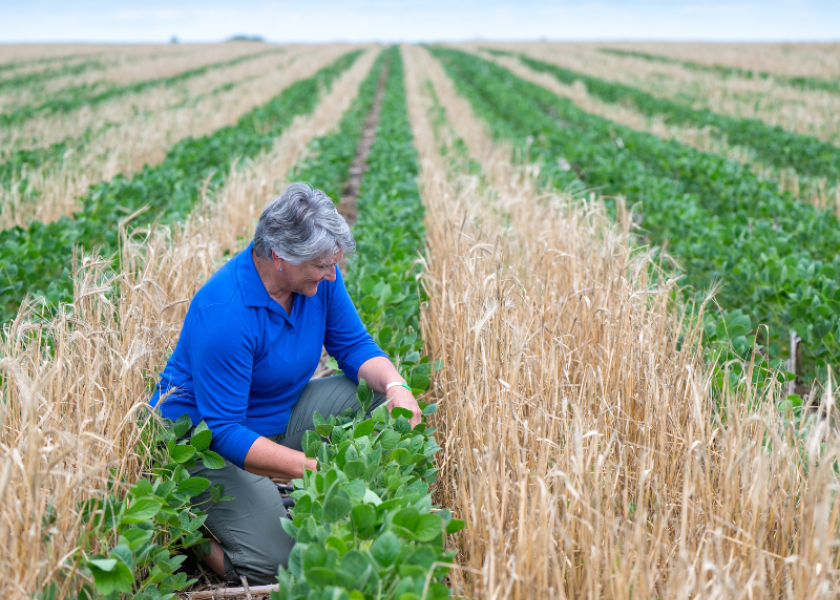From Soil to Plate: Cover Crops Initiative Aims to Boost Soil Health and Your Bottom Line

It’s no secret—pigs need fed. While pork producers may be doing their part in environmental stewardship, it’s important to note that the sustainability and efficiency picture is a web. It includes a number of pieces to a very connected and intertwined image seen by the consumer.
“Approximately 60% of our land, water and carbon footprint comes from feed production,” says Jamie Burr, chief sustainability officer at the National Pork Board. “Anything that we can do to improve and work with grain farmers to improve their footprint improves the pork production footprint.”
Livestock producers and row crop farmers now have the opportunity to move the needle in creating a more sustainable product from farm to plate.
Corn and soybean growers across 20 states are invited to participate in the transformative cost-share program offered by Farmers for Soil Health. A pioneering initiative in corn, pork and soy commodities, this collaboration with the National Fish and Wildlife Foundation and USDA’s Partnerships for Climate-Smart Commodities promises financial and technical aid to growers embracing cover crops. The core objective is to bolster the financial returns of farmers who are actively driving sustainability at the grassroots level.
Championed by the National Corn Growers Association, National Pork Board and United Soybean Board, Farmers for Soil Health stands committed to advancing conservation practices that enhance soil health across the U.S. The overarching goal of doubling cover crop acres to 30 million by 2030 reflects their aspiration to provide practical, science-backed solutions, exemplifying the dedication of farmers nationwide.
“Consumers expect agriculture to continuously look at ways to improve environmental outcomes and this is an opportunity to do that,” explains Jamie Burr, chief sustainability officer at the National Pork Board. “To be partnered with United States Soybean Board and National Corn Growers Association, this grant program puts production practices and conservation practices on the ground to improve those environmental outcomes—showing that pork producers are leaders in the space as they have been for a long time.”
How Does the Program Work?
Participating growers who integrate cover crops into their practices will receive transition support amounting to $50 per new acre of cover crops planted, disbursed over a span of three years. This payment structure, delivering $2 per acre, extends to a cap of 600,000 acres of existing cover crops.

Eligible farmers will engage in measurement, reporting and verification processes aimed at accentuating the progress made in expanding cover crop adoption. The enrollment process is streamlined and is available to farmers in Delaware, Illinois, Indiana, Iowa, Kansas, Kentucky, Maryland, Michigan, Minnesota, Missouri, Nebraska, New York, North Carolina, North Dakota, Ohio, Pennsylvania, South Dakota, Tennessee, Virginia and Wisconsin.
A hallmark of this initiative is its simplicity in both enrollment and monitoring. The online enrollment platform ensures swift and effortless participation, while remote monitoring and verification via satellite technology add a layer of convenience.
Why It Matters
Burr explains the power in this initiative using this formula:
Principles + Practices + Proof = Public Trust
“If you think about principles, those are our six We Care® Ethical Principles. The practices are the metrics and goals that pork producers have set for each one of those We Care ethical principles. Then the proof is in collecting this data on, for instance, the number of acres of cover crops or the amount of water that you use, that equals public trust,” Burr adds.
While sensitivity to data is something Burr acknowledges greatly, he says without data, we don’t have an accurate story to tell.
In addition to data, Burr says this initiative highlights the symbiotic relationship between row crop and livestock production—as if it’s a chain.
“The more links that we can link together to form a chain, just like on a farm, the longer that chain is, the more that we can do with it,” he explains. “Also, a vast majority of the footprint of pork production, if you look at it from a lifecycle assessment perspective, comes from crop farming that comes from most feed inputs. So, if we can work together and be united as one ag, then we can use that longer chain to have improvements from both a farmer survivability resilence, their long-term sustainability and then providing that proof to consumers.
Along with building upon the relationship between row crop and pig farmers, as well as the financial and technical assistance received as part of the program, benefits to farmers can also be found at ground level.
“Protecting the soils we farm is so important. Cover crops and conservation tillage are key tools that can be used to prevent erosion by keeping living roots in the ground,” says Neal Bredehoeft, soy checkoff farmer-leader from Missouri, in a recent release. “In partnership with my brothers, we have been practicing no-till on our farms for 30 years and using cover crops for almost 10 years. Cover crops are another conservation measure that helps us keep our soils in place and crop nutrients in the fields where they belong.”

For a comprehensive understanding of the Farmers for Soil Health initiative or to apply, visit farmersforsoilhealth.com.
More Opportunities
The National Pork Board recently announced its $20 million USDA Climate Smart Commodity grant, with pig farmers in Minnesota, Iowa and Missouri eligible to apply, following an on-farm sustainability report.
With flexibility in the grant program, eligible practices will be tailored to growers’ needs with reporting progress focused on meaningful climate benefits, notes the release.
Specifically, the release notes climate-smart production practices suitable for the region and production systems include:
- Cover crops
- Livestock integration (in cover crops)
- Reduced or no tillage
- Reduced fertilizer application
- Manure management, like pumping twice per year
- Edge-of-field grass buffers
- In-barn adjustments like switching to LED lighting
Though this Climate Smart Grant is regionalized, the Pork Cares Farm Impact Report tool is available to all producers across the U.S.







